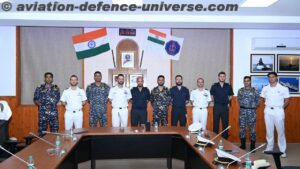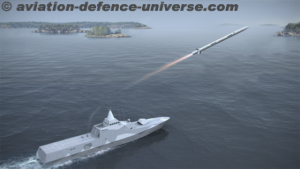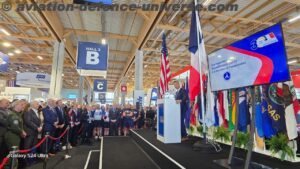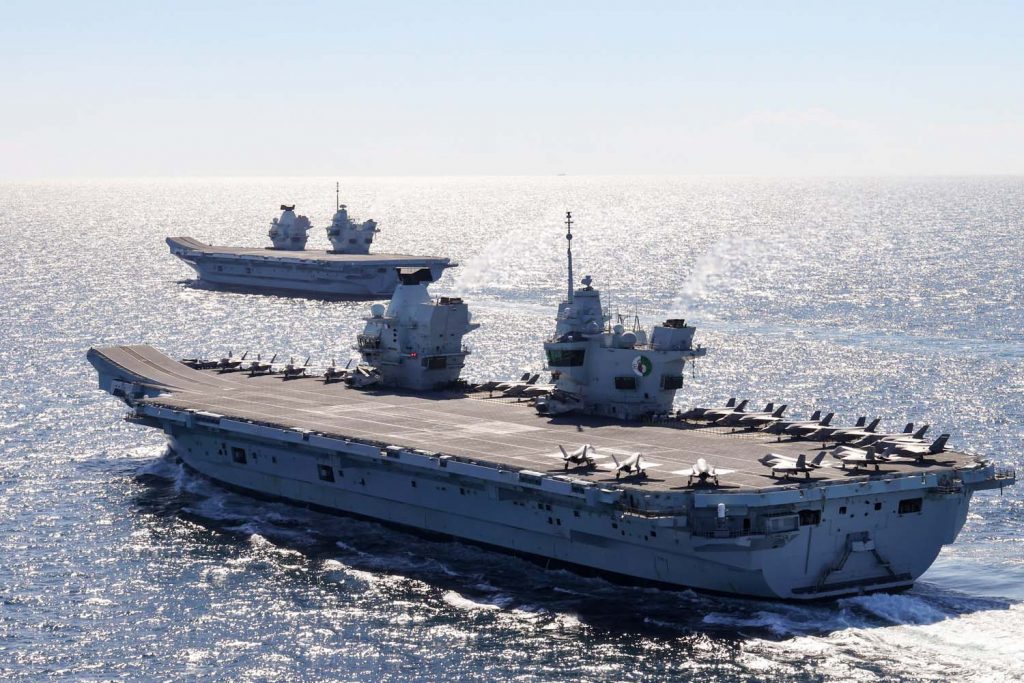

By Commodore Anil Jai Singh, IN(Retd)
New Delhi. 25 May 2021. A Royal Navy Carrier Task Force led by its flagship, the 65000 ton aircraft carrier HMS Queen Elizabeth (QE) departed from Portsmouth harbour over the weekend on a 26000 mile deployment to the Indo-Pacific in what is perhaps the most powerful Royal Navy deployment in the 20th century. Hailed as the return of British maritime power and a manifestation of post Brexit ‘Global Britain’, the significance of this deployment is reflected in Prime Minister Boris Johnson’s visit to the ship in Portsmouth harbour two days before its departure. He emphasised that this deployment marks the end of the era of ‘Britain in retreat’ and is part of his promise to restore the UK to its earlier as Europe’s foremost naval power.
The QE (not to be mistaken with the luxury liner , the QE 2) , with an impressive aviation complement embarked on board which includes joint UK-US F-35B Lightning 2 strike fast jets and various helicopters optimised for different roles, is being accompanied by two Type 45 destroyers HMS Defender and Diamond, two Type 23 anti-submarine frigates HMS Kent and HMS Richmond and two Royal Fleet Auxiliaries RFA Fort Victoria and RFA Tidespring. The US Navy’s Arleigh Burke class destroyer USS The Sullivans and the Dutch frigate, HNLMS Evertsen will also be part of the of the Strike Group. Surprisingly, there is no mention of a nuclear attack submarine (SSN) accompanying the CTF unless one of the Astute class SSNs will join later.
The seven month deployment will continue till December 2021 and will transit from Portsmouth to the Mediterranean and onwards into the Red Sea, the Gulf of Aden, the Arabian Sea , the Indian ocean and there onwards to the Philippine Sea. Enroute to the Indo-Pacific the CTF will interact with many of the UK’s allies and in the Pacific, it will participate in Exercise Barsama Lima which will also mark 50 years of the Five Power Defence Alliance (FPDA) comprising Malaysia, Singapore, Australia, New Zealand and the UK
Continuing a Rich Legacy
The Queen Elizabeth is one of two aircraft carriers, the other being the Prince of Wales which were built in the last decade and were commissioned in December 2017 and December 2019 respectively. The commissioning of two large aircraft carriers, with an expected service life of 50 years indicates the UK’s intent to retain its standing as major naval power. Displacing over 65000 tons, these are the largest warships ever built in Great Britain and are worthy successors to a rich British legacy of carrier operations which began with its first aircraft carrier HMS Argus which was commissioned in 1918 soon after Squadron Commander Edwin Dunning made the first successful aircraft landing on HMS Furious while she was making way through water in the August of the previous year.
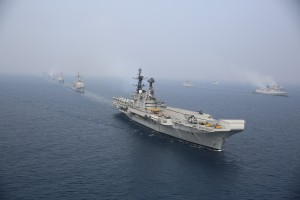
In these 100 years, the UK remained at the forefront of aircraft carrier technology through the two world wars and for some years thereafter till the USA introduced their large nuclear powered carriers. The angled flight deck which is almost standard for aircraft carriers was designed by the British. In the post World war 2 era too, British carriers continued to projct British power. In 1982, when Argentina annexed the Falkland Islands, a British territory in the South Atlantic, the British Task Force which sailed over 8000 miles and reclaimed the Falklands was led by the aircraft carriers HMS Hermes ( which later served in the Indian Navy as INS Viraat till 2016) and HMS Illustrious. While the Royal Navy continued to operate three light carriers, it was evident that their days were numbered as the political leadership, in its typical naivete inflicted bruising cuts on the Royal Navy’s budget which led to all three being decommissioned in the first decade of this century thus allowing a legacy and experience of almost a hundred years to be squandered. Finally, after lengthy deliberations which went on for a few years and seemed to be more about retaining jobs rather than operational capability, these two carriers got the nod.
There has been some criticism within the UK on the wisdom of this extended deployment to the east; the first being about the Chinese perception about the reasons for this deployment and the second being that the should have been more NATO-centric. However, the British Government’s recent Integrated Review highlighting Prime Minister Boris Johnson’s vision of a ‘Global Britain’ has clearly articulated the importance of the Indo-Pacific, the UK’s concerns with China and consequent ‘tilt’ to the Indo-Pacific. Although the specifics have not been spelt out. the intended message that a post-Brexit UK is charting its own course in its engagement with the world in which the Indo-Pacific, for obvious reasons figures prominently is unambiguous.
Why the ‘Tilt’ to the Indo-Pacific ?
The strategic importance of the Indo-Pacific needs no emphasis. Driven by the rise of China which has clearly articulated its intention of dominating this region enroute to displacing the USA as the global superpower, it has, through a series of actions challenged the existing rules-based international order; its maritime belligerence and expansionist approach with an utter disregard for existing rules and conventions (despite being a signatory to them ) is posing a severe threat to the sanctity of the global commons as the common heritage of mankind and more specifically to a Free and Open Indo-Pacific. Its Grey Zone strategy, its sharp power, its wolf warrior diplomacy and its predatory skill at exploiting vulnerabilities in others impacts not only the countries in the region but also those that have trade and other maritime interests in the region.
The Indo-Pacific region is home to over 60% of the global population and generates 60 % of the global GDP. The impact of globalisation and an interconnected world has led to trade dependencies across geographies and highlighted the need for robust and resilient supply chains. Any threat to the safe passage of trade and energy which criss-crosses this region on board more than 120,000 ships annually will have a severe impact on the global economy which countries simply cannot afford. The nature of the maritime threat is also changing with an increase in the transnational and sub-conventional asymmetric challenges that also pose a threat to global commerce. Responding to these requires an inclusive and cooperative approach which has led even Euro-centric countries like Germany and the Netherlands to articulate their own Indo-Pacific strategies to ensure a Free and Open Indo-Pacific and to maintain a rules-based international order. These are primarily aimed at protecting their trade interests but also includes a token naval presence in the region. Germany is likely to deploy one frigate to the Indo-Pacific and the British CTF is likely to have a Dutch naval presence.
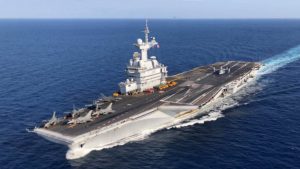
France, which has a major stake in the Indo-Pacific with a number of French territories and most importantly, 90%of its EEZ located in these waters has a substantial naval presence in the region and is enhancing its engagement with the Quad countries. Its only aircraft carrier. the nuclear-powered Charles de Gaulle has been frequenting these waters. It recently participated in a Quad+1 exercise in the region. It is also strengthening its relationship with India not only through operational interaction but also through defence -industrial cooperation.
UK, which had once dominated the Indian Ocean to an extent that it was called a British lake had to cede that position to the USA after the second world war when its presence became unsustainable. In the seven decades since, the Royal Navy’s involvement has dwindled further even though all credit must be given to the RN for being able to maintain its global footprint despite the drastic reduction in its force levels. It still has a one star Maritime Component Commander in Bahrain and has been an active participant in CTFs 150,151 and Op Atalanta in the western Indian Ocean. It has regularly deployed ships for participation in Exercise Konkan with the Indian Navy in the Indian Ocean and has frequently deployed it ships to the western Pacific as well. However, this CTF deployment is different and in the words of the UK’s Secretary of State for Defence Ben Wallace, “The deployment is a symbol of Global Britain in action. It powerfully demonstrates our commitment to India, the Indo-Pacific region, and confronting threats to international order.”
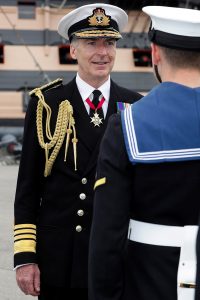
The First Sea Lord and Chief of the Naval Staff of the Royal Navy Admiral Tony Radakin, said that this deployment is about the Navy “flying the flag for Britain and carrying forward the Prime Minister’s vision” of a “Global Britain”. The Indo-Pacific is becoming increasingly contentious. Tensions over Taiwan , Hongkong , the South China Sea, Chinese militarisation and its expansionist agenda are causing concern. The Quad, while propagating a wider agenda of maritime cooperation cannot distance itself from its concerns over China as was evident from the statements that emanated from Japan and the USA after Prime Minister Suga’s visit to Washington DC. The Quad’s objective of ensuring a rules- based international order and a Free and Open Indo-Pacific is shared by ‘like-minded’ nations across the globe but is viewed by China as a strategy meant to counter its rise.
There has also been speculation about the expansion of the Quad and pushing that a bit further, the possible formation of an Asian NATO. However, both these possibilities have been discounted from within and outside the Quad. The Quad itself prefers to remain an informal construct with a convergence of interests. The presence of like-minded extra regional powers with an interest in ensuring a Free and Open Indo-Pacific can strengthen the response capability of this construct against the multitude of maritime security challenges facing this region. Hence the deployment of CTF 21 will send a strong signal of the UK’s global concern at events in the Indo-Pacific and also signal its return as a maritime power willing to play a larger role in the region.
The Indo-UK perspective
From an Indo-UK perspective, the CTF’s visit to India will enhance the bilateral trade and political relationship signalling Prime Minister Boris Johnson’s intent to deepen its relationship with India. His own visit, scheduled in April had to be postponed due to the pandemic. Despite the deep historical ties and an influential Indian diaspora in the UK, the depth of the strategic bilateral relationship has always fallen short of expectations. Hence this visit hopes to establish a maritime partnership with India to enhance maritime security in the Indian Ocean. In the defence -industrial sphere too, other countries have made much deeper inroads. Traditionally, a UK aircraft carrier visit also includes a showcasing of the UK’s defence- industrial prowess which may be the case this time too. A very obvious area of discussion could be aircraft carrier technology since the UK has successfully built these two 65000 tonne aircraft carriers with electric propulsion and India’s plan is to build one of similar tonnage and capability.

In the words of the UK Secretary of State for Defence Ben Wallace, “The UK and India are natural defence partners, particularly in world class research, development and training. The Carrier Strike Group’s collaboration with India will build the foundations for this relationship to flourish even further.” This could therefore be the opportunity to review and revitalise the post-Brexit UK-India strategic relationship.
Conclusion
From a purely Indian perspective, it is hoped that the UK’s past experience of neglecting its carrier power and the importance now being attached to this deployment could better enlighten those in the decision making loop of the Indian MoD including the highest uniformed office in the land whose lack of exposure to the maritime domain and disregard for the advice of those who have spent a lifetime there is so woefully obvious.
The author Commodore AJ Singh is an ex-submariner of the Indian Navy and a defence expert. He is the Vice President at Indian Maritime Foundation. The views in the article are solely the author’s. He can be contacted at editor.adu@gmail.com






































